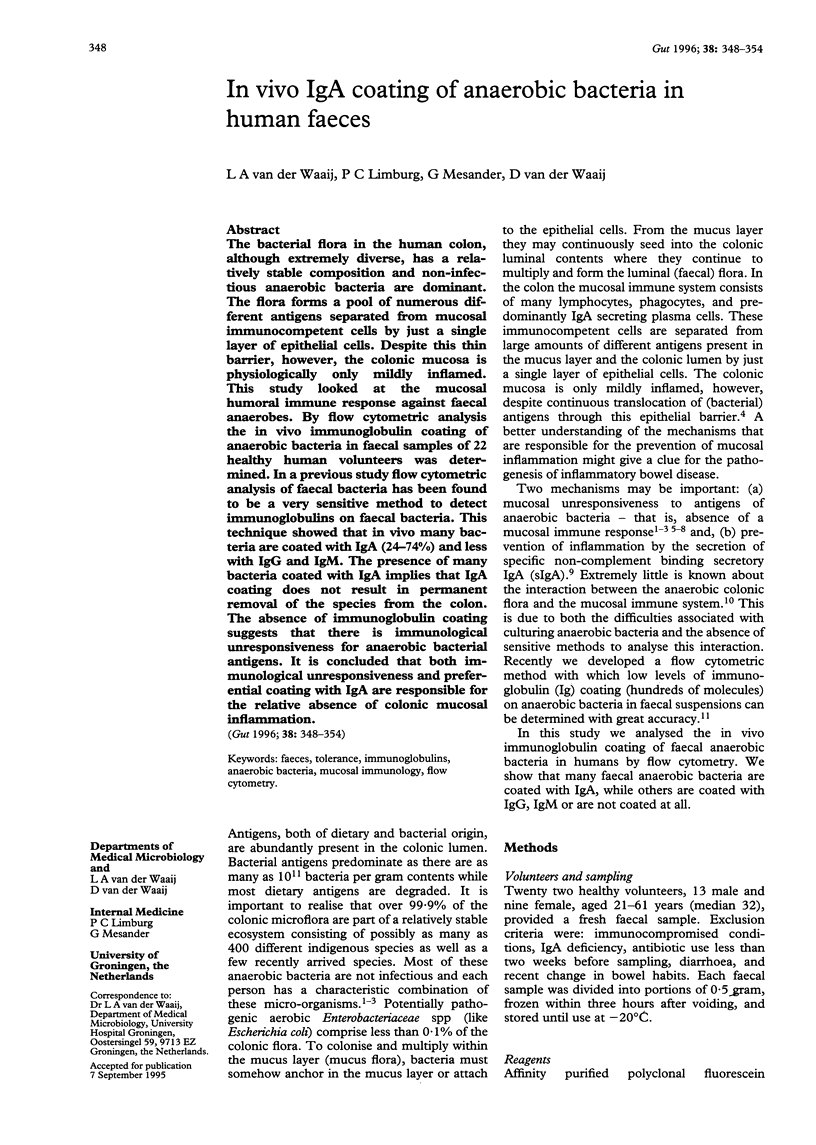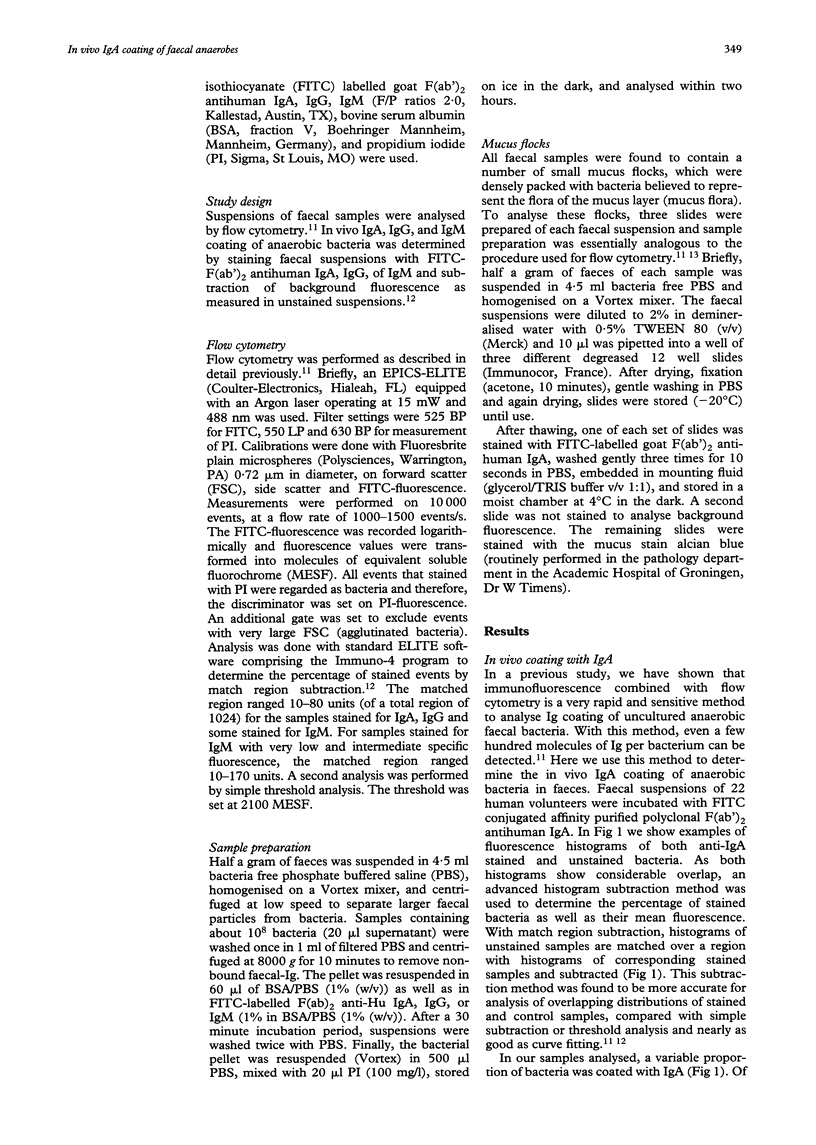Abstract
The bacterial flora in the human colon, although extremely diverse, has a relatively stable composition and non-infectious anaerobic bacteria are dominant. The flora forms a pool of numerous different antigens separated from mucosal immunocompetent cells by just a single layer of epithelial cells. Despite this thin barrier, however, the colonic mucosa is physiologically only mildly inflamed. This study looked at the mucosal humoral immune response against faecal anaerobes. By flow cytometric analysis the in vivo immunoglobulin coating of anaerobic bacteria in faecal samples of 22 healthy human volunteers was determined. In a previous study flow cytometric analysis of faecal bacteria has been found to be a very sensitive method to detect immunoglobulins on faecal bacteria. This technique showed that in vivo many bacteria are coated with IgA (24-74%) and less with IgG and IgM. The presence of many bacteria coated with IgA implies that IgA coating does not result in permanent removal of the species from the colon. The absence of immunoglobulin coating suggests that there is immunological unresponsiveness for anaerobic bacterial antigens. It is concluded that both immunological unresponsiveness and preferential coating with IgA are responsible for the relative absence of colonic mucosal inflammation.
Full text
PDF






Images in this article
Selected References
These references are in PubMed. This may not be the complete list of references from this article.
- Apperloo-Renkema H. Z., Wilkinson M. H., van der Waaij D. Circulating antibodies against faecal bacteria assessed by immunomorphometry: combining quantitative immunofluorescence and image analysis. Epidemiol Infect. 1992 Dec;109(3):497–506. doi: 10.1017/s0950268800050494. [DOI] [PMC free article] [PubMed] [Google Scholar]
- Brandtzaeg P., Bjerke K., Kett K., Kvale D., Rognum T. O., Scott H., Sollid L. M., Valnes K. Production and secretion of immunoglobulins in the gastrointestinal tract. Ann Allergy. 1987 Nov;59(5 Pt 2):21–39. [PubMed] [Google Scholar]
- Brandtzaeg P., Valnes K., Scott H., Rognum T. O., Bjerke K., Baklien K. The human gastrointestinal secretory immune system in health and disease. Scand J Gastroenterol Suppl. 1985;114:17–38. doi: 10.3109/00365528509093765. [DOI] [PubMed] [Google Scholar]
- Childers N. K., Bruce M. G., McGhee J. R. Molecular mechanisms of immunoglobulin A defense. Annu Rev Microbiol. 1989;43:503–536. doi: 10.1146/annurev.mi.43.100189.002443. [DOI] [PubMed] [Google Scholar]
- Conley M. E., Delacroix D. L. Intravascular and mucosal immunoglobulin A: two separate but related systems of immune defense? Ann Intern Med. 1987 Jun;106(6):892–899. doi: 10.7326/0003-4819-106-6-892. [DOI] [PubMed] [Google Scholar]
- Duval-Iflah Y., Raibaud P., Rousseau M. Antagonisms among isogenic strains of Escherichia coli in the digestive tracts of gnotobiotic mice. Infect Immun. 1981 Dec;34(3):957–969. doi: 10.1128/iai.34.3.957-969.1981. [DOI] [PMC free article] [PubMed] [Google Scholar]
- Elson C. O. Induction and control of the gastrointestinal immune system. Scand J Gastroenterol Suppl. 1985;114:1–15. doi: 10.3109/00365528509093764. [DOI] [PubMed] [Google Scholar]
- Ferretti J. J., Shea C., Humphrey M. W. Cross-reactivity of Streptococcus mutans antigens and human heart tissue. Infect Immun. 1980 Oct;30(1):69–73. doi: 10.1128/iai.30.1.69-73.1980. [DOI] [PMC free article] [PubMed] [Google Scholar]
- Foo M. C., Lee A. Antigenic cross-reaction between mouse intestine and a member of the autochthonous microflora. Infect Immun. 1974 Jun;9(6):1066–1069. doi: 10.1128/iai.9.6.1066-1069.1974. [DOI] [PMC free article] [PubMed] [Google Scholar]
- Gossling J., Slack J. M. Predominant gram-positive bacteria in human feces: numbers, variety, and persistence. Infect Immun. 1974 Apr;9(4):719–729. doi: 10.1128/iai.9.4.719-729.1974. [DOI] [PMC free article] [PubMed] [Google Scholar]
- Hahn-Zoric M., Carlsson B., Jalil F., Mellander L., Germanier R., Hanson L. A. The influence on the secretory IgA antibody levels in lactating women of oral typhoid and parenteral cholera vaccines given alone or in combination. Scand J Infect Dis. 1989;21(4):421–426. doi: 10.3109/00365548909167447. [DOI] [PubMed] [Google Scholar]
- Logan A. C., Chow K. P., George A., Weinstein P. D., Cebra J. J. Use of Peyer's patch and lymph node fragment cultures to compare local immune responses to Morganella morganii. Infect Immun. 1991 Mar;59(3):1024–1031. doi: 10.1128/iai.59.3.1024-1031.1991. [DOI] [PMC free article] [PubMed] [Google Scholar]
- Monteiro E., Fossey J., Shiner M., Drasar B. S., Allison A. C. Antibacterial antibodies in rectal and colonic mucosa in ulcerative colitis. Lancet. 1971 Feb 6;1(7693):249–250. doi: 10.1016/s0140-6736(71)90997-4. [DOI] [PubMed] [Google Scholar]
- Moore W. E., Holdeman L. V. Human fecal flora: the normal flora of 20 Japanese-Hawaiians. Appl Microbiol. 1974 May;27(5):961–979. doi: 10.1128/am.27.5.961-979.1974. [DOI] [PMC free article] [PubMed] [Google Scholar]
- Owen R. L., Pierce N. F., Apple R. T., Cray W. C., Jr M cell transport of Vibrio cholerae from the intestinal lumen into Peyer's patches: a mechanism for antigen sampling and for microbial transepithelial migration. J Infect Dis. 1986 Jun;153(6):1108–1118. doi: 10.1093/infdis/153.6.1108. [DOI] [PubMed] [Google Scholar]
- Riviere G. R., Wagoner M. A., Freeman I. L. Chronic peroral immunization of conventional laboratory rats with mutans streptococci leads to stable acquired suppression of salivary antibodies. Oral Microbiol Immunol. 1992 Jun;7(3):137–141. doi: 10.1111/j.1399-302x.1992.tb00526.x. [DOI] [PubMed] [Google Scholar]
- Silverman G. J. Human antibody responses to bacterial antigens: studies of a model conventional antigen and a proposed model B cell superantigen. Int Rev Immunol. 1992;9(1):57–78. doi: 10.3109/08830189209061783. [DOI] [PubMed] [Google Scholar]
- Simon G. L., Gorbach S. L. Intestinal flora in health and disease. Gastroenterology. 1984 Jan;86(1):174–193. [PubMed] [Google Scholar]
- Sladek T. L., Jacobberger J. W. Flow cytometric titration of retroviral expression vectors: comparison of methods for analysis of immunofluorescence histograms derived from cells expressing low antigen levels. Cytometry. 1993;14(1):23–31. doi: 10.1002/cyto.990140106. [DOI] [PubMed] [Google Scholar]
- Stephen A. M., Cummings J. H. The microbial contribution to human faecal mass. J Med Microbiol. 1980 Feb;13(1):45–56. doi: 10.1099/00222615-13-1-45. [DOI] [PubMed] [Google Scholar]
- Svanborg-Edén C., Svennerholm A. M. Secretory immunoglobulin A and G antibodies prevent adhesion of Escherichia coli to human urinary tract epithelial cells. Infect Immun. 1978 Dec;22(3):790–797. doi: 10.1128/iai.22.3.790-797.1978. [DOI] [PMC free article] [PubMed] [Google Scholar]
- Wells C. L., Maddaus M. A., Simmons R. L. Proposed mechanisms for the translocation of intestinal bacteria. Rev Infect Dis. 1988 Sep-Oct;10(5):958–979. doi: 10.1093/clinids/10.5.958. [DOI] [PubMed] [Google Scholar]
- Williams R. C., Gibbons R. J. Inhibition of bacterial adherence by secretory immunoglobulin A: a mechanism of antigen disposal. Science. 1972 Aug 25;177(4050):697–699. doi: 10.1126/science.177.4050.697. [DOI] [PubMed] [Google Scholar]
- Yu D. T., Hamachi T., Hamachi M., Tribbick G. Analysis of the molecular mimicry between HLA-B27 and a bacterial OmpA protein using synthetic peptides. Clin Exp Immunol. 1991 Sep;85(3):510–514. doi: 10.1111/j.1365-2249.1991.tb05758.x. [DOI] [PMC free article] [PubMed] [Google Scholar]
- van der Waaij D., Berghuis-de Vries J. M., Lekkerkerk Lekkerkerk-v Colonization resistance of the digestive tract in conventional and antibiotic-treated mice. J Hyg (Lond) 1971 Sep;69(3):405–411. doi: 10.1017/s0022172400021653. [DOI] [PMC free article] [PubMed] [Google Scholar]
- van der Waaij D. The ecology of the human intestine and its consequences for overgrowth by pathogens such as Clostridium difficile. Annu Rev Microbiol. 1989;43:69–87. doi: 10.1146/annurev.mi.43.100189.000441. [DOI] [PubMed] [Google Scholar]
- van der Waaij L. A., Mesander G., Limburg P. C., van der Waaij D. Direct flow cytometry of anaerobic bacteria in human feces. Cytometry. 1994 Jul 1;16(3):270–279. doi: 10.1002/cyto.990160312. [DOI] [PubMed] [Google Scholar]



